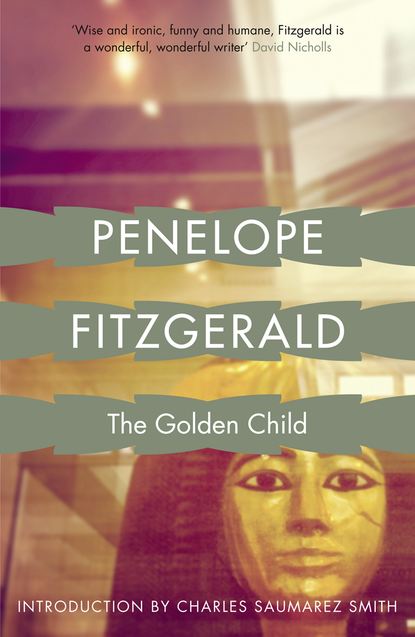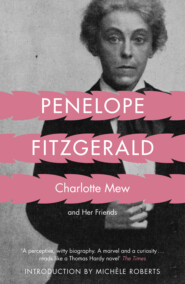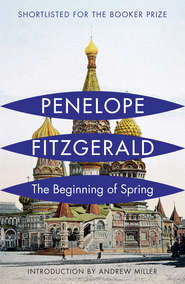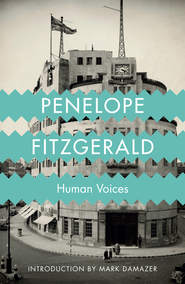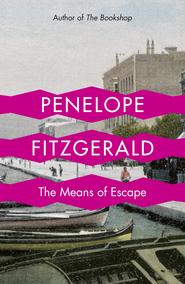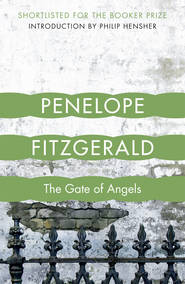По всем вопросам обращайтесь на: info@litportal.ru
(©) 2003-2024.
✖
The Golden Child
Автор
Год написания книги
2018
Настройки чтения
Размер шрифта
Высота строк
Поля
The Golden Child
Penelope Fitzgerald
The Golden Child, Penelope Fitzgerald’s first work of fiction, is a classically plotted British mystery centred around the arrival of the ‘Golden Child’ at a London museum.Far be it for the hapless Waring Smith, junior officer at a prominent London museum, to expect any kind of thanks for his work on the opening of the year’s biggest exhibition – The Golden Child. But when he is nearly strangled to death by a shadowy assailant and packed off to Moscow to negotiate with a mysterious curator, he finds himself at the centre of a sinister web of conspiracy, fraudulent artifacts and murder…Her first novel and a comic gem, ‘The Golden Child’ is written with the sharp wit and unerring eye for human foibles that mark Penelope Fitzgerald out as a truly inimitable author, and one to be cherished.
PENELOPE FITZGERALD
The Golden Child
Dedication (#ulink_6f6629f0-a927-5b67-a3f8-c529379ee742)
For Desmond
Contents
Cover (#u67d65143-75a2-5fd1-89a7-e2244034f0fa)
Title Page (#u0268be5b-3fbd-59c1-a3ee-d0af00c12185)
Dedication (#u5fbc8d68-a91d-5fae-a918-26769c8cca88)
Penelope Fitzgerald: Preface by Hermione Lee, Advisory Editor (#ud695068a-a43d-5963-a2a8-1c87f3c8275c)
Introduction (#u87d58131-7941-55d3-8757-4f51ef8b93f7)
Chapter 1 (#u3bb64e91-cc73-5afe-99a4-0515bef3f000)
Chapter 2 (#udd5cda02-3d6b-5f9c-bf45-f4fba13a96b3)
Chapter 3 (#litres_trial_promo)
Chapter 4 (#litres_trial_promo)
Chapter 5 (#litres_trial_promo)
Chapter 6 (#litres_trial_promo)
By the Same Author (#litres_trial_promo)
Copyright (#litres_trial_promo)
About the Publisher (#litres_trial_promo)
Penelope Fitzgerald Preface by Hermione Lee, Advisory Editor (#ulink_3f717c0b-9861-5519-8d14-39380d726520)
When Penelope Fitzgerald unexpectedly won the Booker Prize with Offshore, in 1979, at the age of sixty-three, she said to her friends: ‘I knew I was an outsider.’ The people she wrote about in her novels and biographies were outsiders, too: misfits, romantic artists, hopeful failures, misunderstood lovers, orphans and oddities. She was drawn to unsettled characters who lived on the edges. She wrote about the vulnerable and the unprivileged, children, women trying to cope on their own, gentle, muddled, unsuccessful men. Her view of the world was that it divided into ‘exterminators’ and ‘exterminatees’. She would say: ‘I am drawn to people who seem to have been born defeated or even profoundly lost.’ She was a humorous writer with a tragic sense of life.
Outsiders in literature were close to her heart, too. She was fond of underrated, idiosyncratic writers with distinctive voices, like the novelist J. L. Carr, or Harold Monro of the Poetry Bookshop, or the remarkable and tragic poet Charlotte Mew. The publisher Virago’s enterprise of bringing neglected women writers back to life appealed to her, and under their imprint she championed the nineteenth-century novelist Margaret Oliphant. She enjoyed eccentrics like Stevie Smith. She liked writers, and people, who stood at an odd angle to the world. The child of an unusual, literary, middle-class English family, she inherited the Evangelical principles of her bishop grandfathers and the qualities of her Knox father and uncles: integrity, austerity, understatement, brilliance and a laconic, wry sense of humour.
She did not expect success, though she knew her own worth. Her writing career was not a usual one. She began publishing late in her life, around sixty, and in twenty years she published nine novels, three biographies and many essays and reviews. She changed publisher four times when she started publishing, before settling with Collins, and she never had an agent to look after her interests, though her publishers mostly became her friends and advocates. She was a dark horse, whose Booker Prize, with her third novel, was a surprise to everyone. But, by the end of her life, she had been shortlisted for it several times, had won a number of other British prizes, was a well-known figure on the literary scene, and became famous, at eighty, with the publication of The Blue Flower and its winning, in the United States, the National Book Critics Circle Award.
Yet she always had a quiet reputation. She was a novelist with a passionate following of careful readers, not a big name. She wrote compact, subtle novels. They are funny, but they are also dark. They are eloquent and clear, but also elusive and indirect. They leave a great deal unsaid. Whether she was drawing on the experiences of her own life – working for the BBC in the Blitz, helping to make a go of a small-town Suffolk bookshop, living on a leaky barge on the Thames in the 1960s, teaching children at a stage-school – or, in her last four great novels, going back in time and sometimes out of England to historical periods which she evoked with astonishing authenticity – she created whole worlds with striking economy. Her books inhabit a small space, but seem, magically, to reach out beyond it.
After her death at eighty-three, in 2000, there might have been a danger of this extraordinary voice fading away into silence and neglect. But she has been kept from oblivion by her executors and her admirers. The posthumous publication of her stories, essays and letters is now being followed by a biography (Penelope Fitzgerald: A Life, by Hermione Lee, Chatto & Windus, 2013), and by these very welcome reissues of her work. The fine writers who have provided introductions to these new editions show what a distinguished following she has. I hope that many new readers will now discover, and fall in love with, the work of one of the most spellbinding English novelists of the twentieth century.
Introduction (#ulink_2d1e0f84-d094-5080-9b19-a79fdd04f9e7)
The Golden Child was Penelope Fitzgerald’s first novel, written in 1975, the year that her biography of Edward Burne-Jones was published. She wrote it as relaxation from her next task of writing a biography of her father and three of her uncles, the Knox Brothers, whose high-minded attitude to literature and life had so influenced her upbringing (her father was editor of Punch and her grandfather Bishop of Manchester).
Fitzgerald had had half a lifetime of struggle, bringing up three children, working as a part-time teacher in two establishments, Queen’s Gate School in Kensington and Westminster Tutors and, after the family home (a barge moored at Chelsea Reach) sank, moving to a council house in Clapham. Her husband, Desmond, an Irish, ex-Guardsman lawyer, whom she had met at Oxford when he was good looking and sociable, later took to drink, and ended up working as a clerk in Lunn Poly, a travel agency.
In her late fifties (she was born in 1916), with her three children grown up, she was at last able to do what she had always wanted and planned to do since getting a first-class degree in English at Somerville College, Oxford, which was to write. Desmond was dying of cancer and she later claimed to have written the book ‘to amuse my husband when he was ill’. He died in August 1975; The Golden Child, published in 1977, was dedicated to him.
For her first novel, Fitzgerald decided to explore the comic possibilities of a story about the British Museum, which she loved and knew well as a visitor, tramping through the great galleries with the children during their school holidays, using it as a place of retreat on her afternoons off from teaching, attending lunchtime lectures. But she wasn’t just interested in the objects in the museum: clearly, she had also been observing the foibles of the staff, the self-importance of the warders, full of gossip as to what was going on in other parts of the museum, filling in their leave forms whilst not paying attention to the visitors, together with the grandee keepers of departments, who had offices behind the scenes. She knew, without necessarily having been told, the tensions between those who loved the objects on display with an unhealthy passion and those who realised that their responsibilities included looking after, and sometimes entertaining, visitors. Her imagination had been able to intuit the backstairs intrigues, the tragi-comic ambitions and the petty rivalries of a great institution.
Fitzgerald’s imagination also drew on the phenomenon of the Tutankhamun exhibition, which was held at the British Museum in 1972 and which had been a spectacular, unprecedented and still unequalled public success. It had exceptionally long visiting hours, open until 9 o’clock in the evening every day, and was seen by over a million and a half people over a period of seven months. Fitzgerald is known to have gone to the exhibition more than once, and had presumably queued, perhaps with her pupils. She discovered, which is true of any great blockbuster, that half the experience and some of the enjoyment, is in the queuing, the sense of anticipation and the camaraderie, the idea of a pilgrimage to witness a group of objects which are in themselves deeply mysterious. She liked to entertain the notion that the exhibition was a fraud: it was actually hard to see the objects properly because of the low level of lighting. She realised how easy it would have been to trick the visitors, and this sparked her imagination.
Fitzgerald invented her own version of the Tutankhamun exhibition, as a show of relics of an ancient African civilisation called Garamantia, which does indeed exist (I had assumed that, as a work of fiction, it was a figment of her imagination). She invented, too, a cast of characters surrounding the exhibition. There is the elderly archaeologist, Sir William Simpkin, who lives in a private flat in the museum, kept on in the expectation that his fortune would be left to the museum director, so that the director would have his own personal fund for acquisitions and not have to pay attention to the competing interests of the keepers. There is Sir John Allison, the museum director, ambitious for himself, unscrupulous, as all museum directors in fiction are expected to be. He bears a more than passing resemblance to Kenneth Clark. There are the two secretaries, the stupendously lazy Dousha Vartarian, who worked for Simpkin, ‘curled in creamy splendour in her typing-chair’, and the director’s secretary, Miss Rank, who was an exceptionally competent person. There is the deputy head of security, left with the task of actually minding the public; Jones, the flat-footed warder of indeterminate rank and function, who is given the task of looking after the requirements of Sir William Simpkin; the Keeper of Funerary Art, Marcus Hawthorne-Mannering (one of Fitzgerald’s pupils at Queen’s Gate had been Eliza Manningham-Buller, who later became a colleague teaching history before entering MI5); a left-wing technician called Len Coker; and the almost-hero of the novel, Waring Smith, a junior exhibitions officer, who is an ingénue, impoverished, as all junior museum employees are, worried about his mortgage and his wife, Haggie, an offstage character who doesn’t like him having to work late.
It is not clear how much Fitzgerald really knew about the realities of working in the British Museum, but what she wasn’t sure of, she was easily able to invent from her knowledge of other bureaucracies, including the BBC, and from friends like Mary Chamot, a Russian émigré who had been an assistant keeper at the Tate Gallery. And she had her own experience of dealing with museum officials whilst writing her biography of Burne-Jones. She told her former publisher, Richard Garnett, that one of the reasons she wrote the book was as an act of revenge against ‘someone who struck me as particularly unpleasant when I was obliged to go a lot to museums & to find out about Burne-Jones’. However she had absorbed her raw material, she had sardonically observed the curious ways of post-war British institutions, the obsessive hierarchies, the technicians who often know far more than the specialists, the left-wing politics, and the sense of superficial busy-ness masking a wider entropy. She knew only too well, and understood and empathised with, the world of middle-class professional impoverishment, the feelings of resentment towards someone who is in any way unusual, and the ways that museum specialists bury themselves in their subject, ignoring the emotional upset of the world around them.
The Golden Child is taut, finely plotted like a thriller, richly comic, with some of the elements of exaggerated satire characteristic of a campus novel, like Malcolm Bradbury’s The History Man, published in 1975. She described it as a ‘mystery story’ and, oddly, never counted it amongst her novels.
I was working in the Victoria and Albert Museum during the 1980s. Aspects of the ways museums operated then are very recognisable, when the not-so-young and dandy museum director, Sir Roy Strong, was holding grand exhibitions to the disdain of his much more posh keepers. Reading the novel now I am struck by how admirably it catches so many of the characteristics of England in the mid-1970s (although no date is given as to when the novel is set and she herself described it as a historical novel): the sense and near enjoyment of hopeless decline, pre-Thatcherite economic irrationality, government jobs supported, but inadequately, by the state, a mirror image of the USSR.
Penelope Fitzgerald came across, to those who knew her, as highly intelligent and hopelessly vague, preoccupied by the world of the inner imagination, an enthusiastic member of the William Morris Society, passionate about art and literature. She was hostile to wealth, as she had been brought up to be by the Knoxes. Having spent much of her life marking scripts by schoolchildren, she disguised from them and her colleagues that she could write like an angel, using words poetically, constructing sentences which are descriptively precise, never conveying anything more than is strictly necessary. This reticence about her own genius partly accounts for why it took so long for the qualities of her fiction to be properly recognised and why her third novel, Offshore, was patronised even when it won the Booker Prize. Her writing reads easily and her books are not long, as if they are written rapidly, but they have an extreme, defined and reticent precision in their use of language.
It was not necessarily a bad thing for her fiction that she spent so much of her adult life unable to find the time to write, bottling up her annoyance with human imperfections, including her own, and observing the world with her sharp views of pomposity.
I only encountered Penelope Fitzgerald once.
It was in 1996, towards the end of her life, when she won the Heywood Hill Prize. The prize-giving was on the lawns of Chatsworth and was combined with an annual meeting of all the mayors of Derbyshire. A colliery band played. The sun shone. Noel Annan gave a speech of great eloquence, placing the writing of her most recent (and last) novel, The Blue Flower, within the realms of European humanism.
In The Golden Child, Fitzgerald was at the beginning of that late-flowering writing career.
Charles Saumarez Smith
2014
1
THE enormous building waited as though braced to defend itself, standing back resolutely from its great courtyard under a frozen January sky, colourless, cloudless, leafless and pigeonless. The courtyard was entirely filled with people. A restrained noise rose from them, like the grinding of the sea at slack water. They made slight surges forward, then back, but always gaining an inch.
Inside the building the Deputy Director, Security, reviewed the disposition of his forces. The duties that led to congratulation and overtime had always in the past been strictly allocated by seniority, as some of the older ones were still, for the hundredth time, pointing out, grumbling that they were not to the fore. ‘‘This is a time when we may need force,’ the DD(S) replied patiently. ‘Experience, too, of course,’ he added conciliatingly. The huge bronze clock in the atrium, at which he glanced, had the peculiarity of waiting and then jumping forwards a whole minute; and this peculiarity made it impossible not to say, Three minutes to go, two minutes to go. ‘Three minutes to go,’ said DD(S). ‘We are all quite clear, I take it. Slight accidents, fainting, trampling under foot — the emergency First Aid posts are indicated in your orders for the day; complaints, show sympathy; disorder, contain; increased disorder, communicate directly with my office; wild disorder, the police, to be avoided if possible. Crush barriers to be kept in place at all entries at all times. No lingering.’
‘Sir William doesn’t approve of that,’ said a resolutely doleful voice.
‘I fail to account for your presence here, Jones. You have already been drafted, and your place, as usual, is in Stores. The real danger point is the approach to the tomb,’ he added in a louder voice; ‘that’s been agreed, both with you and higher up.’ The bronze hand jumped the last minute, both inside and on the public face outside the building, and with the august movement of a natural disaster the wave of human beings lapped up the steps and entered the hall. The first public day of the Museum’s winter exhibition of the Golden Child had begun.
It was the dreaded Primary Schools day. The courtyards had been partitioned by the darkly gleaming posters announcing the Exhibition. On each poster was a pale representation, in the style of Maurice Denis, of the Golden Child and the Ball of Golden Twine, with much fancy lettering, and a promise of reduced prices of admission for the very old and the very young. The moving files wound, like a barbarian horde, among these golden posters: five or six thousand children, mostly dressed in blue cotton trousers once thought suitable only for oppressed Chinese peasants, and little plastic jackets; half unconscious with cold, having long since eaten the sandwiches which were intended for several hours later, more or less under the control of numbed teachers, insistent, single-minded, determined to see and to have seen. Like pilgrims of a former day, they were earning their salvation by reaching the end of a journey.
Penelope Fitzgerald
The Golden Child, Penelope Fitzgerald’s first work of fiction, is a classically plotted British mystery centred around the arrival of the ‘Golden Child’ at a London museum.Far be it for the hapless Waring Smith, junior officer at a prominent London museum, to expect any kind of thanks for his work on the opening of the year’s biggest exhibition – The Golden Child. But when he is nearly strangled to death by a shadowy assailant and packed off to Moscow to negotiate with a mysterious curator, he finds himself at the centre of a sinister web of conspiracy, fraudulent artifacts and murder…Her first novel and a comic gem, ‘The Golden Child’ is written with the sharp wit and unerring eye for human foibles that mark Penelope Fitzgerald out as a truly inimitable author, and one to be cherished.
PENELOPE FITZGERALD
The Golden Child
Dedication (#ulink_6f6629f0-a927-5b67-a3f8-c529379ee742)
For Desmond
Contents
Cover (#u67d65143-75a2-5fd1-89a7-e2244034f0fa)
Title Page (#u0268be5b-3fbd-59c1-a3ee-d0af00c12185)
Dedication (#u5fbc8d68-a91d-5fae-a918-26769c8cca88)
Penelope Fitzgerald: Preface by Hermione Lee, Advisory Editor (#ud695068a-a43d-5963-a2a8-1c87f3c8275c)
Introduction (#u87d58131-7941-55d3-8757-4f51ef8b93f7)
Chapter 1 (#u3bb64e91-cc73-5afe-99a4-0515bef3f000)
Chapter 2 (#udd5cda02-3d6b-5f9c-bf45-f4fba13a96b3)
Chapter 3 (#litres_trial_promo)
Chapter 4 (#litres_trial_promo)
Chapter 5 (#litres_trial_promo)
Chapter 6 (#litres_trial_promo)
By the Same Author (#litres_trial_promo)
Copyright (#litres_trial_promo)
About the Publisher (#litres_trial_promo)
Penelope Fitzgerald Preface by Hermione Lee, Advisory Editor (#ulink_3f717c0b-9861-5519-8d14-39380d726520)
When Penelope Fitzgerald unexpectedly won the Booker Prize with Offshore, in 1979, at the age of sixty-three, she said to her friends: ‘I knew I was an outsider.’ The people she wrote about in her novels and biographies were outsiders, too: misfits, romantic artists, hopeful failures, misunderstood lovers, orphans and oddities. She was drawn to unsettled characters who lived on the edges. She wrote about the vulnerable and the unprivileged, children, women trying to cope on their own, gentle, muddled, unsuccessful men. Her view of the world was that it divided into ‘exterminators’ and ‘exterminatees’. She would say: ‘I am drawn to people who seem to have been born defeated or even profoundly lost.’ She was a humorous writer with a tragic sense of life.
Outsiders in literature were close to her heart, too. She was fond of underrated, idiosyncratic writers with distinctive voices, like the novelist J. L. Carr, or Harold Monro of the Poetry Bookshop, or the remarkable and tragic poet Charlotte Mew. The publisher Virago’s enterprise of bringing neglected women writers back to life appealed to her, and under their imprint she championed the nineteenth-century novelist Margaret Oliphant. She enjoyed eccentrics like Stevie Smith. She liked writers, and people, who stood at an odd angle to the world. The child of an unusual, literary, middle-class English family, she inherited the Evangelical principles of her bishop grandfathers and the qualities of her Knox father and uncles: integrity, austerity, understatement, brilliance and a laconic, wry sense of humour.
She did not expect success, though she knew her own worth. Her writing career was not a usual one. She began publishing late in her life, around sixty, and in twenty years she published nine novels, three biographies and many essays and reviews. She changed publisher four times when she started publishing, before settling with Collins, and she never had an agent to look after her interests, though her publishers mostly became her friends and advocates. She was a dark horse, whose Booker Prize, with her third novel, was a surprise to everyone. But, by the end of her life, she had been shortlisted for it several times, had won a number of other British prizes, was a well-known figure on the literary scene, and became famous, at eighty, with the publication of The Blue Flower and its winning, in the United States, the National Book Critics Circle Award.
Yet she always had a quiet reputation. She was a novelist with a passionate following of careful readers, not a big name. She wrote compact, subtle novels. They are funny, but they are also dark. They are eloquent and clear, but also elusive and indirect. They leave a great deal unsaid. Whether she was drawing on the experiences of her own life – working for the BBC in the Blitz, helping to make a go of a small-town Suffolk bookshop, living on a leaky barge on the Thames in the 1960s, teaching children at a stage-school – or, in her last four great novels, going back in time and sometimes out of England to historical periods which she evoked with astonishing authenticity – she created whole worlds with striking economy. Her books inhabit a small space, but seem, magically, to reach out beyond it.
After her death at eighty-three, in 2000, there might have been a danger of this extraordinary voice fading away into silence and neglect. But she has been kept from oblivion by her executors and her admirers. The posthumous publication of her stories, essays and letters is now being followed by a biography (Penelope Fitzgerald: A Life, by Hermione Lee, Chatto & Windus, 2013), and by these very welcome reissues of her work. The fine writers who have provided introductions to these new editions show what a distinguished following she has. I hope that many new readers will now discover, and fall in love with, the work of one of the most spellbinding English novelists of the twentieth century.
Introduction (#ulink_2d1e0f84-d094-5080-9b19-a79fdd04f9e7)
The Golden Child was Penelope Fitzgerald’s first novel, written in 1975, the year that her biography of Edward Burne-Jones was published. She wrote it as relaxation from her next task of writing a biography of her father and three of her uncles, the Knox Brothers, whose high-minded attitude to literature and life had so influenced her upbringing (her father was editor of Punch and her grandfather Bishop of Manchester).
Fitzgerald had had half a lifetime of struggle, bringing up three children, working as a part-time teacher in two establishments, Queen’s Gate School in Kensington and Westminster Tutors and, after the family home (a barge moored at Chelsea Reach) sank, moving to a council house in Clapham. Her husband, Desmond, an Irish, ex-Guardsman lawyer, whom she had met at Oxford when he was good looking and sociable, later took to drink, and ended up working as a clerk in Lunn Poly, a travel agency.
In her late fifties (she was born in 1916), with her three children grown up, she was at last able to do what she had always wanted and planned to do since getting a first-class degree in English at Somerville College, Oxford, which was to write. Desmond was dying of cancer and she later claimed to have written the book ‘to amuse my husband when he was ill’. He died in August 1975; The Golden Child, published in 1977, was dedicated to him.
For her first novel, Fitzgerald decided to explore the comic possibilities of a story about the British Museum, which she loved and knew well as a visitor, tramping through the great galleries with the children during their school holidays, using it as a place of retreat on her afternoons off from teaching, attending lunchtime lectures. But she wasn’t just interested in the objects in the museum: clearly, she had also been observing the foibles of the staff, the self-importance of the warders, full of gossip as to what was going on in other parts of the museum, filling in their leave forms whilst not paying attention to the visitors, together with the grandee keepers of departments, who had offices behind the scenes. She knew, without necessarily having been told, the tensions between those who loved the objects on display with an unhealthy passion and those who realised that their responsibilities included looking after, and sometimes entertaining, visitors. Her imagination had been able to intuit the backstairs intrigues, the tragi-comic ambitions and the petty rivalries of a great institution.
Fitzgerald’s imagination also drew on the phenomenon of the Tutankhamun exhibition, which was held at the British Museum in 1972 and which had been a spectacular, unprecedented and still unequalled public success. It had exceptionally long visiting hours, open until 9 o’clock in the evening every day, and was seen by over a million and a half people over a period of seven months. Fitzgerald is known to have gone to the exhibition more than once, and had presumably queued, perhaps with her pupils. She discovered, which is true of any great blockbuster, that half the experience and some of the enjoyment, is in the queuing, the sense of anticipation and the camaraderie, the idea of a pilgrimage to witness a group of objects which are in themselves deeply mysterious. She liked to entertain the notion that the exhibition was a fraud: it was actually hard to see the objects properly because of the low level of lighting. She realised how easy it would have been to trick the visitors, and this sparked her imagination.
Fitzgerald invented her own version of the Tutankhamun exhibition, as a show of relics of an ancient African civilisation called Garamantia, which does indeed exist (I had assumed that, as a work of fiction, it was a figment of her imagination). She invented, too, a cast of characters surrounding the exhibition. There is the elderly archaeologist, Sir William Simpkin, who lives in a private flat in the museum, kept on in the expectation that his fortune would be left to the museum director, so that the director would have his own personal fund for acquisitions and not have to pay attention to the competing interests of the keepers. There is Sir John Allison, the museum director, ambitious for himself, unscrupulous, as all museum directors in fiction are expected to be. He bears a more than passing resemblance to Kenneth Clark. There are the two secretaries, the stupendously lazy Dousha Vartarian, who worked for Simpkin, ‘curled in creamy splendour in her typing-chair’, and the director’s secretary, Miss Rank, who was an exceptionally competent person. There is the deputy head of security, left with the task of actually minding the public; Jones, the flat-footed warder of indeterminate rank and function, who is given the task of looking after the requirements of Sir William Simpkin; the Keeper of Funerary Art, Marcus Hawthorne-Mannering (one of Fitzgerald’s pupils at Queen’s Gate had been Eliza Manningham-Buller, who later became a colleague teaching history before entering MI5); a left-wing technician called Len Coker; and the almost-hero of the novel, Waring Smith, a junior exhibitions officer, who is an ingénue, impoverished, as all junior museum employees are, worried about his mortgage and his wife, Haggie, an offstage character who doesn’t like him having to work late.
It is not clear how much Fitzgerald really knew about the realities of working in the British Museum, but what she wasn’t sure of, she was easily able to invent from her knowledge of other bureaucracies, including the BBC, and from friends like Mary Chamot, a Russian émigré who had been an assistant keeper at the Tate Gallery. And she had her own experience of dealing with museum officials whilst writing her biography of Burne-Jones. She told her former publisher, Richard Garnett, that one of the reasons she wrote the book was as an act of revenge against ‘someone who struck me as particularly unpleasant when I was obliged to go a lot to museums & to find out about Burne-Jones’. However she had absorbed her raw material, she had sardonically observed the curious ways of post-war British institutions, the obsessive hierarchies, the technicians who often know far more than the specialists, the left-wing politics, and the sense of superficial busy-ness masking a wider entropy. She knew only too well, and understood and empathised with, the world of middle-class professional impoverishment, the feelings of resentment towards someone who is in any way unusual, and the ways that museum specialists bury themselves in their subject, ignoring the emotional upset of the world around them.
The Golden Child is taut, finely plotted like a thriller, richly comic, with some of the elements of exaggerated satire characteristic of a campus novel, like Malcolm Bradbury’s The History Man, published in 1975. She described it as a ‘mystery story’ and, oddly, never counted it amongst her novels.
I was working in the Victoria and Albert Museum during the 1980s. Aspects of the ways museums operated then are very recognisable, when the not-so-young and dandy museum director, Sir Roy Strong, was holding grand exhibitions to the disdain of his much more posh keepers. Reading the novel now I am struck by how admirably it catches so many of the characteristics of England in the mid-1970s (although no date is given as to when the novel is set and she herself described it as a historical novel): the sense and near enjoyment of hopeless decline, pre-Thatcherite economic irrationality, government jobs supported, but inadequately, by the state, a mirror image of the USSR.
Penelope Fitzgerald came across, to those who knew her, as highly intelligent and hopelessly vague, preoccupied by the world of the inner imagination, an enthusiastic member of the William Morris Society, passionate about art and literature. She was hostile to wealth, as she had been brought up to be by the Knoxes. Having spent much of her life marking scripts by schoolchildren, she disguised from them and her colleagues that she could write like an angel, using words poetically, constructing sentences which are descriptively precise, never conveying anything more than is strictly necessary. This reticence about her own genius partly accounts for why it took so long for the qualities of her fiction to be properly recognised and why her third novel, Offshore, was patronised even when it won the Booker Prize. Her writing reads easily and her books are not long, as if they are written rapidly, but they have an extreme, defined and reticent precision in their use of language.
It was not necessarily a bad thing for her fiction that she spent so much of her adult life unable to find the time to write, bottling up her annoyance with human imperfections, including her own, and observing the world with her sharp views of pomposity.
I only encountered Penelope Fitzgerald once.
It was in 1996, towards the end of her life, when she won the Heywood Hill Prize. The prize-giving was on the lawns of Chatsworth and was combined with an annual meeting of all the mayors of Derbyshire. A colliery band played. The sun shone. Noel Annan gave a speech of great eloquence, placing the writing of her most recent (and last) novel, The Blue Flower, within the realms of European humanism.
In The Golden Child, Fitzgerald was at the beginning of that late-flowering writing career.
Charles Saumarez Smith
2014
1
THE enormous building waited as though braced to defend itself, standing back resolutely from its great courtyard under a frozen January sky, colourless, cloudless, leafless and pigeonless. The courtyard was entirely filled with people. A restrained noise rose from them, like the grinding of the sea at slack water. They made slight surges forward, then back, but always gaining an inch.
Inside the building the Deputy Director, Security, reviewed the disposition of his forces. The duties that led to congratulation and overtime had always in the past been strictly allocated by seniority, as some of the older ones were still, for the hundredth time, pointing out, grumbling that they were not to the fore. ‘‘This is a time when we may need force,’ the DD(S) replied patiently. ‘Experience, too, of course,’ he added conciliatingly. The huge bronze clock in the atrium, at which he glanced, had the peculiarity of waiting and then jumping forwards a whole minute; and this peculiarity made it impossible not to say, Three minutes to go, two minutes to go. ‘Three minutes to go,’ said DD(S). ‘We are all quite clear, I take it. Slight accidents, fainting, trampling under foot — the emergency First Aid posts are indicated in your orders for the day; complaints, show sympathy; disorder, contain; increased disorder, communicate directly with my office; wild disorder, the police, to be avoided if possible. Crush barriers to be kept in place at all entries at all times. No lingering.’
‘Sir William doesn’t approve of that,’ said a resolutely doleful voice.
‘I fail to account for your presence here, Jones. You have already been drafted, and your place, as usual, is in Stores. The real danger point is the approach to the tomb,’ he added in a louder voice; ‘that’s been agreed, both with you and higher up.’ The bronze hand jumped the last minute, both inside and on the public face outside the building, and with the august movement of a natural disaster the wave of human beings lapped up the steps and entered the hall. The first public day of the Museum’s winter exhibition of the Golden Child had begun.
It was the dreaded Primary Schools day. The courtyards had been partitioned by the darkly gleaming posters announcing the Exhibition. On each poster was a pale representation, in the style of Maurice Denis, of the Golden Child and the Ball of Golden Twine, with much fancy lettering, and a promise of reduced prices of admission for the very old and the very young. The moving files wound, like a barbarian horde, among these golden posters: five or six thousand children, mostly dressed in blue cotton trousers once thought suitable only for oppressed Chinese peasants, and little plastic jackets; half unconscious with cold, having long since eaten the sandwiches which were intended for several hours later, more or less under the control of numbed teachers, insistent, single-minded, determined to see and to have seen. Like pilgrims of a former day, they were earning their salvation by reaching the end of a journey.





